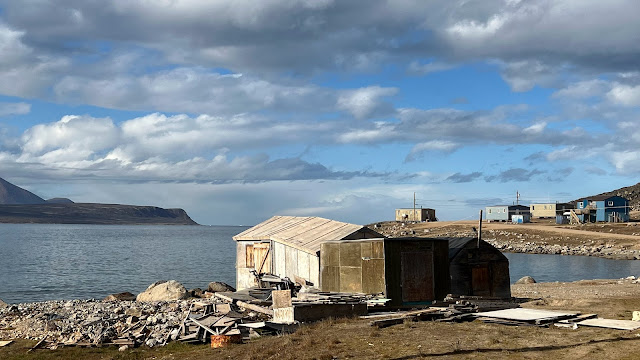 |
| Inuit homeland in Canada |
This morning we arrived at Qikiqtarjuaq on Broughton Island (near Baffin Island). Qikiqtarjuag or Qik (for those of us who struggle to pronounce the name which is practically everyone) is known as ‘the Iceberg Capital of the world’. Most of the icebergs come from Greenland glaciers, and are carried there on the ocean current, breaking into pieces, forming smaller icebergs and floating ice. Sometimes the icebergs run aground along the coast and the people harvest the ice to use as clean drinking water; it’s a very dry place. We had arrived in Inuit Nunangat, the Inuit homeland in Canada, and I was feeling quite excited. Four Royal Canadian Mounted Police came on board to clear us to enter Canada (and no they weren’t mounted haha). While the Mounties did their job, we had a lecture on Arctic marine mammals and a Citizen Science workshop all of which was wrapped up with a biosecurity check – new land new bio-risks.
 |
| There was a welcoming committee of smiling faces |
 |
| This grandfather brought a string of little ones to say hello |
After lunch and with us all cleared to enter Canada, we hopped into zodiacs and went ashore to meet our local guides - many of the local people were lined up at the beach to welcome us where we landed. A grandfather with a string of little ones in tow, thanked us for bringing good weather the dear man.As we wandered through town we were followed by kids and young adults curious to ask us questions. The landscape is barren yet I found some wildflowers – when I was able to stop to look around.
 |
| This is one of our guides |
 |
| The area is bone dry and rather desolate looking |
We were curios and were pursued by happy youngsters keen to touch, keen for us to photograph them. It was quite delightful. We trundled around, in our gumboots, and got a very good look at the village. It must be quite spectacular in winter or at least with snow.
 |
| The tusk from a freshly-killed Narwhal |
We met a hunter who was keen to show us the tusk of a narwhal he had killed that morning; the meat had already been distributed to the village. He told us that he had recently killed a two-tusked narwhal, a very rare creature. He sold the tusks/head for $US60,000. Only the Inuit can kill Narwhals and I think they are rare. Seal are different and thee Ring Seals are among the most important species in the culture of the Inuit people of this place. In the museum we saw beautiful clotging made from Ring Seal skins. They harvest the seals in open water, or through their breathing holes in the ice.
 |
| Beautiful clothing made from Ring Seal skins |
 |
| A beautiful mandala of the Inuit calendar of the seasons |
Another display which caught my eye was the Inuit calendar of seasons. It has at least six seasons (some versions are even more complex). They use the moon to keep track of the 'calendar year', counting thirteen ‘moon months’. Each month is named for a predictable seasonal characteristic, mostly related to animal behavior, which coincides with a particular moon. This beautiful ‘mandala’ reminded me of the Australian Aboriginal season mandala we saw in East Arnhem Land some years ago.
We spent quite some time in the museum and community hall but then it was time to head back to the ship. It had been a very interesting visit.
We arrived back on board in time for cocktails and canapes! But then it was time for the precap and recap. These often included a mini-lecture about what we were about to see or a little snippet of history of the NW Passage. After dinner they screened a movie as they did many nights (but we were too pooped to stay awake). This one was a 1922 silent docudrama (in the style/tradition they refer to as salvage ethnography. It followed the struggles of an Inuit man and his family in the Canadian Arctic. We were asleep before it finished!
 |
| The sun went down in a glorious pageant as we traveled northwards |














No comments:
Post a Comment